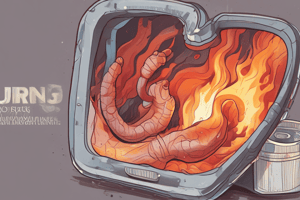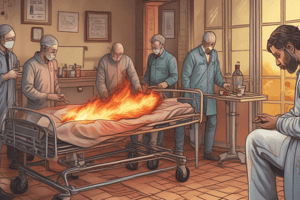Podcast
Questions and Answers
List three factors that influence the selection of a specific agent and dressing for a burn wound.
List three factors that influence the selection of a specific agent and dressing for a burn wound.
Wound depth, location of the injury, and presence of infection.
Briefly describe the primary goal of wound cleansing during burn wound care.
Briefly describe the primary goal of wound cleansing during burn wound care.
The primary goal is to remove loose tissue to allow for proper visualization of the burn wound.
What is the main purpose of enzymatic debridement, and for what type of burn wounds is it often reserved?
What is the main purpose of enzymatic debridement, and for what type of burn wounds is it often reserved?
The purpose is to hasten eschar separation and wound healing. It is often reserved for deep partial-thickness wounds with signs of healing, or full-thickness burns in patients not suitable for surgery.
Explain why early excision and grafting are considered beneficial in burn management.
Explain why early excision and grafting are considered beneficial in burn management.
Why is autograft considered the 'ideal replacement' for lost skin in burn injuries?
Why is autograft considered the 'ideal replacement' for lost skin in burn injuries?
What is the most common donor site for split-thickness skin grafts, and why is it preferred?
What is the most common donor site for split-thickness skin grafts, and why is it preferred?
Describe the key difference in application between sheet grafts and meshed grafts, and explain why this difference exists.
Describe the key difference in application between sheet grafts and meshed grafts, and explain why this difference exists.
What is the purpose of meshing a skin graft, and what is a common expansion ratio used?
What is the purpose of meshing a skin graft, and what is a common expansion ratio used?
In burn wound debridement, what tools are typically used for the removal of loose tissue during wound cleansing?
In burn wound debridement, what tools are typically used for the removal of loose tissue during wound cleansing?
Under what circumstances might a burn surgeon choose to apply a full-thickness skin graft, even though split-thickness grafts are more common?
Under what circumstances might a burn surgeon choose to apply a full-thickness skin graft, even though split-thickness grafts are more common?
When does the intermediate phase of burn management typically begin?
When does the intermediate phase of burn management typically begin?
What is the primary method used for cleansing burn wounds in most burn centers, and why is it preferred?
What is the primary method used for cleansing burn wounds in most burn centers, and why is it preferred?
Is burn wound care considered a sterile or clean procedure? Explain the difference.
Is burn wound care considered a sterile or clean procedure? Explain the difference.
Why is the temperature often kept high during burn dressing changes?
Why is the temperature often kept high during burn dressing changes?
Besides wound cleansing, what other important assessments and interventions take place during burn dressing changes?
Besides wound cleansing, what other important assessments and interventions take place during burn dressing changes?
What are the main priorities of medical management during the intermediate phase of burn care?
What are the main priorities of medical management during the intermediate phase of burn care?
How has the practice of hydrotherapy evolved in burn centers?
How has the practice of hydrotherapy evolved in burn centers?
Describe the typical duration and complexity of burn dressing changes.
Describe the typical duration and complexity of burn dressing changes.
Flashcards
Intermediate Phase
Intermediate Phase
Period after resuscitation; focuses on wound healing and pain management.
Wound Care Management
Wound Care Management
Prioritize healing, infection prevention, and patient comfort during care.
Hydrotherapy
Hydrotherapy
Cleansing method using water for thorough wound cleaning in burn units.
Clean Technique
Clean Technique
Signup and view all the flashcards
Infection Control
Infection Control
Signup and view all the flashcards
Dressing Changes
Dressing Changes
Signup and view all the flashcards
Topical Medicines
Topical Medicines
Signup and view all the flashcards
Burn Wound Assessment
Burn Wound Assessment
Signup and view all the flashcards
Wound cleansing methods
Wound cleansing methods
Signup and view all the flashcards
Types of debridement
Types of debridement
Signup and view all the flashcards
Mechanical debridement
Mechanical debridement
Signup and view all the flashcards
Enzymatic debridement
Enzymatic debridement
Signup and view all the flashcards
Indications for enzymatic debridement
Indications for enzymatic debridement
Signup and view all the flashcards
Surgical debridement
Surgical debridement
Signup and view all the flashcards
Autograft
Autograft
Signup and view all the flashcards
Split-thickness skin grafts
Split-thickness skin grafts
Signup and view all the flashcards
Donor site for skin grafts
Donor site for skin grafts
Signup and view all the flashcards
Sheet vs. meshed grafts
Sheet vs. meshed grafts
Signup and view all the flashcards
Study Notes
Intermediate Phase of Burn Management
- Begins 48-72 hours after initial injury
- Focus shifts from life-threatening issues to wound healing, pain management, nutrition, and infection prevention
- Continued respiratory and circulatory monitoring remains crucial
Wound Care Practices
- Hydrotherapy: Preferred cleansing method at most burn centers
- Enables thorough cleaning and removal of residual agents/tissue
- Recent methods use portable shower trolleys to reduce cross-contamination
- Bedside care is option for patients not tolerating extensive hydrotherapy
- Clean Technique: Not sterile, aims to reduce microorganisms
- Uses clean field, gloves, and instruments
- Dressing changes can last 2-4 hours
- Patient rooms often maintained at 90°F (32.2°C) to prevent hypothermia
- Assessing wound progression and infection signs is critical during each dressing change
- Physical and occupational therapists assess wound and function/range of motion during dressing changes
- Topical Medications/Dressings: Many types are available
- Choice depends on wound depth, location, infection status, and provider preference
Wound Debridement
- Wound Cleansing: Often done with mild soap/chlorhexidine and sterile water/saline with gentle debridement.
- Debridement removes loose tissue to visualize burn wound
- Debridement Types:
- Mechanical: Uses tweezers, scissors, gauze removal, and hydrotherapy
- Enzymatic: Applies proteolytic ointment; hastens eschar separation; often used for deep partial-thickness wounds or full-thickness burns not needing surgery
- Surgical: Used if mechanical and enzymatic methods are unsuccessful
Surgical Treatment and Wound Closure
- Early Excision and Grafting: Reduces hospital stay and improves survival
- Performed when patient is hemodynamically stable
- Common for large full-thickness burns within 24-48 hours of admission
- Autografts: Preferred method; patient's own skin
- Harvesting epidermis and partial dermis from unburned area (donor site)
- Common donor sites include the thigh, scalp, and scrotum
- Can be reharvested numerous times
- Sheet grafts: For areas needing a seamless cosmetic look (face, hands)
- Mesh grafts: Used when unburned skin is limited to maximize wound coverage; have holes for expansion (expansion ratio 1:2 to 1:4)
- Full-thickness grafts: Used for specific anatomical areas (eyelids) for optimal function.
Studying That Suits You
Use AI to generate personalized quizzes and flashcards to suit your learning preferences.




